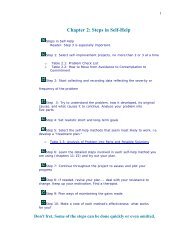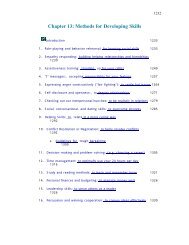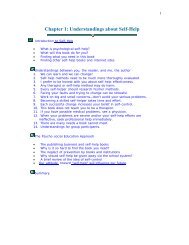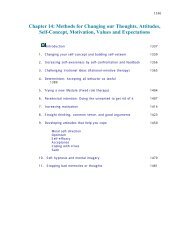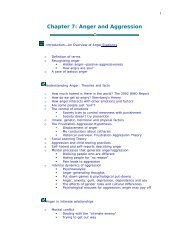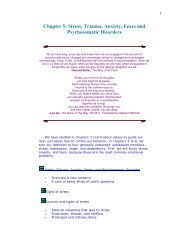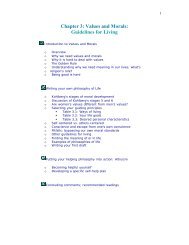Methods for Changing Behaviors - Psychological Self-Help
Methods for Changing Behaviors - Psychological Self-Help
Methods for Changing Behaviors - Psychological Self-Help
You also want an ePaper? Increase the reach of your titles
YUMPU automatically turns print PDFs into web optimized ePapers that Google loves.
personal pride in the skills, self-discipline and values involved in<br />
the activity.<br />
2. Covert negative rein<strong>for</strong>cement--first imagine a very unpleasant<br />
scene and then start imagining the desired target behavior and<br />
feelings which are associated with the termination of the<br />
unpleasant scene. Example: a shy person could imagine being<br />
very nervous at a party and dreading being approached. He/she<br />
further imagines being approached and asked some questions<br />
which he/she handles nicely and even with some wit. The<br />
nervousness goes away as he/she responds to the questions<br />
(thus, rein<strong>for</strong>cing the social interaction). A similar example<br />
would be a person suffering speech phobia; he/she could<br />
imagine being terrified be<strong>for</strong>e a TV interview but as he/she<br />
handles the situation adroitly in fantasy, the terror immediately<br />
subsides. See discussion in method #17. In some cases, it may<br />
be better to terminate a fear, threat, or unpleasant fantasy that<br />
is completely different from your actual concern (it is another<br />
trial at learning the unwanted fear).<br />
3. Covert sensitization or punishment--imagine the unwanted<br />
behavior vividly and in detail, followed immediately with<br />
fantasies of some very unpleasant event, such as vomiting<br />
(Cautela's favorite punishment or UCS). Examples: a smoker<br />
might imagine having the urge to smoke and getting ready to<br />
light up. He/she immediately imagines getting nauseous and<br />
finally, just as he/she thinks of lighting the cigarette, he/she<br />
imagines vomiting all over the cigarette, his/her clothes, people<br />
near by and so on. The same could be done with food, alcohol,<br />
unwanted sexual urges, worries, jealous thoughts, angry<br />
thoughts and acts, etc., i.e. pair them with vomit or any other<br />
unpleasant thought.<br />
4. Covert extinction--imagine doing the unwanted target behavior<br />
and receiving no rein<strong>for</strong>cement or reaction of any kind.<br />
Example: a person with lots of aches and pains could imagine<br />
telling his/her complaints to many people who have no reaction<br />
at all. A clown or flirt or braggart or gossip or spiteful person<br />
could do the same thing.<br />
5. Combinations: Homme suggested a sequence of four thoughts-<br />
-(a) the unwanted urge, (b) an unpleasant thought, (c) a<br />
desired behavior, and (d) a pleasant thought. You can see how<br />
(b) and (d) punish and rein<strong>for</strong>ce (a) and (c). Suppose one is<br />
sexually turned on by an inappropriate person (wrong sex, too<br />
young, too old, married, otherwise unavailable or<br />
uninteresting). One might imagine the urge (only briefly, not<br />
too much!) followed by unpleasant thoughts ("I'd get hurt" or<br />
"That would get me in terrible trouble" or imagining vomiting).<br />
Then think of a more realistic, loving and available relationship,<br />
followed by a pleasant scene or a small reward.<br />
The method of "thought stopping" is another useful covert<br />
procedure (method # 10). In a therapy case, Cautela commonly uses<br />
several covert techniques at the same time to change several<br />
behaviors or emotions.<br />
1148



